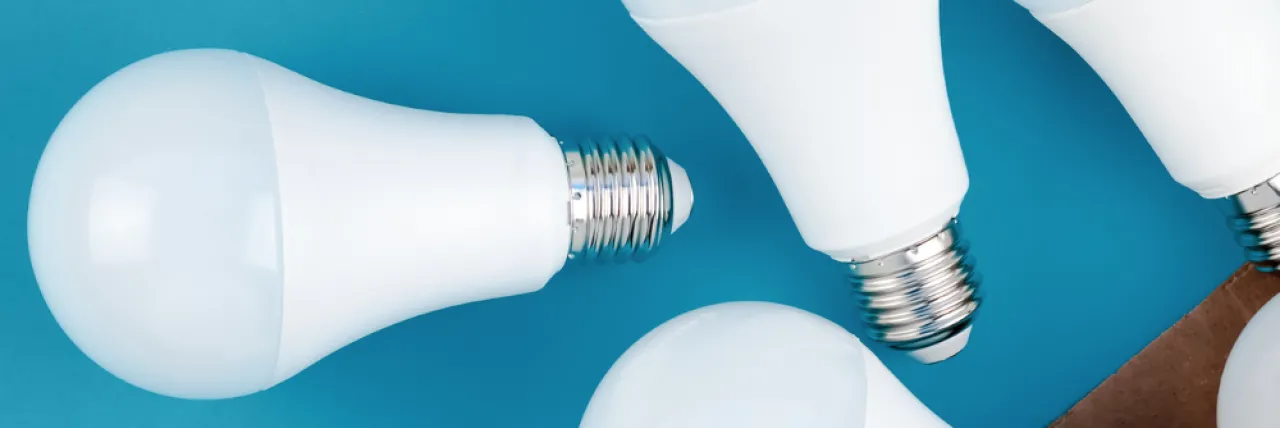Simple & Effective Things You Can Do Year-Round to Save Energy
The cheapest and cleanest energy is the energy you don’t use. Improving the efficiency of your home can pay off multiple times over. Use the tips below to save money year-round.
Adjust your thermostat
Programming your thermostat saves a typical home $180 a year. If you have a manual thermostat, adjust the temperature before you go to bed or when you will be away from home for several hours. (If you have a heat pump, it’s generally not recommended to change your thermostat throughout the day – which may lead to higher bills. Heat pumps work most efficiently when set at a steady temperature.)
Conduct an energy audit to better understand your home energy use. Energy audits can identify air leaks in your home, assess the safety of your appliances, and provide you with suggestions to make your home more energy efficient. Many utilities provide discounted audits, and free audits are available to many income-qualified households.
Eliminate air leaks in your home
Check doors, windows, walls, floors, electrical outlets, the roof, and other areas where different building materials meet, as gaps may allow air to escape from the home. Seal leaks with caulk or weatherstripping.
Switch out old, inefficient bulbs
LEDs use 85% less energy than incandescent bulbs, and a single LED bulb can last over 13 years, so it pays off to spend a bit more upfront. When buying LEDs, look for the Energy Star certification to make sure you’re getting a quality product.
Unplug electronics
Unplug your TV, computer, phone charger, and other electronics when they’re not in use, or use power strips to cut off power automatically. Many electronics continue to draw power even when they’re not being used.
Take a look at CUB’s ideas to increase your home’s energy efficiency with home shell and appliance projects. The cheapest energy is the energy you don’t use.
Seasonal Tips
Keep your home comfortable and reduce your energy usage through whatever Minnesota's weather brings.

Winter
- Adjust your thermostat. One of our top tips for energy consumers with a forced air furnace: set the temperature at 68 degrees when you are awake and turn it down (up to 10 degrees) while you are away or asleep. Be sure to never lower the temperature below 55 degrees to prevent frozen pipes.
- Use the sun. Open window treatments to let the sun in during the day to heat your home naturally. At night, close them to trap the heat inside.
- Cover up air leaks. Use plastic film on windows if they are drafty. Use door draft stoppers to keep cold air out – a rolled-up towel works.
- Cook and bake efficiently. Use lids on pots and pans to reduce cooking time. Bake multiple things at once. Use crockpots, toaster ovens, and microwaves to save energy.
- Celebrate the holidays with LED lights. If you decorate with lights, purchase LED holiday lights.
- Have your furnace/boiler serviced each year and change furnace filters regularly. This will ensure the unit is running safely and efficiently.
- Use space heaters safely and efficiently. Even just one space heater can use a ton of energy over the course of a month. Only have space heaters on when you are in the room and keep items around them at a safe distance.
- Bundle up. Warm clothes, blankets, and socks are key in the winter. Rugs are another great way to help your home feel warmer.
- Inspect and clean your fireplace. Make sure your fireplace is safe. Close fireplace dampers when you are not using them to prevent heat from escaping.
- Redirect ceiling fans. Switch the rotation of ceiling fans to clockwise and operate them at a slow rate to circulate warm air down from the ceiling.

Spring
- Adjust your thermostat based on the weather. For cold weather, set it at 68 degrees or lower when you are at home and up to 10 degrees cooler when you are away or at night. If it’s warm outside, set your thermostat to the highest comfortable temperature to reduce air conditioner usage and save energy. A programmable or smart thermostat can do this automatically.
- Note: If you have a heat pump, it's generally not recommended to change your thermostat throughout the day.
- Manage the sun. Keep window treatments open on cool days to let in the warm sun and close them on hot days to keep your home cool.
- Get your air conditioning unit or heat pump professionally serviced. Make sure your AC unit is ready to cool you down during hot weather and is free of outside debris.
- Open windows to naturally cool your home.
- Use fans, instead of or with air conditioners, as the weather warms. Switch the rotation of ceiling fans counterclockwise to circulate cold air down from the ceiling.
- Replace furnace filters regularly. If you have a central air conditioning system, air continues to travel through your furnace system. Filters can help with allergens, and clean filters keep your mechanical systems working efficiently.
- Sign up for the air conditioning cycling program offered by your local utility if you have central air conditioning. You receive a discount for allowing the utility to cycle your air conditioner on and off during peak energy times.
- Take short showers instead of baths to reduce hot water consumption in your home.
- Use the bathroom fan to prevent excess heat and humidity from escaping into the rest of your home.
- Clean refrigerator coils while you are spring cleaning. You should clean coils twice a year or more frequently if you have pets.

Summer
- Adjust your air conditioner. When you are home, set the thermostat as high as comfortable and turn up a few degrees higher when you are away. This allows you to be energy efficient and remain comfortable.
- Use a programmable thermostat with an auto setting to control when your air conditioning turns on and off during the day.
- Sign up for the air conditioning cycling program offered by your local utility if you have central air conditioning. You receive a discount for allowing the utility to cycle your air conditioner on and off during peak energy times.
- Use fans instead of, or with, air conditioners. Fans can make you feel 4 degrees cooler. Turn fans off when you leave the room to save energy. A fan makes you feel cooler; it doesn’t reduce the room temperature.
- Remove obstacles from air vents and fans to ensure proper air flow throughout your home.
- Avoid placing lamps or TVs near the thermostat. Thermostats can detect heat from these appliances and can cause the air conditioner to run longer than necessary.
- Open windows in the morning and evening to allow cool air to flow in. On hot days, close windows and curtains to maintain cool temperatures.
- Use the bathroom fan to remove excess heat and humidity from escaping into the rest of your home.
- Avoid cooking, baking, and running appliances, such as a clothes dryer, that generate heat during the warmest parts of the day.
- Look for an Energy Star-rated model when it’s time to replace your appliance and mechanical systems. It will use less energy and save you money over time, and you may qualify for a rebate from your utility company.

Fall
- Adjust your thermostat. One of our top tips for energy consumers with a forced air furnace: set the temperature at 68 degrees when you are awake and turn it down (up to 10 degrees) while you are away or asleep.
- Use a programmable or smart thermostat to control when your furnace turns on and off throughout the day.
- Have your furnace/boiler serviced each year and change furnace filters regularly to make sure it runs efficiently as the weather starts to cool down.
- Use the sun. Open your curtains and blinds throughout the day to allow sunlight to naturally heat your home.
- Check windows and doors for leaks and seal leaks before the cold weather arrives.
- Clean refrigerator coils. You should clean coils twice a year or more frequently if you have pets.
- Cook and bake efficiently. Use lids on pots and pans to reduce cooking time. Bake multiple things at once. Use crockpots, toaster ovens, and microwaves to save energy.
- Keep fridge and freezers full, but not crowded. If your fridge or freezer is empty, fill milk jugs with water to fill up space, and throw out old food if it’s too full.
- Inspect and clean your fireplace. Make sure your fireplace is safe. Close fireplace dampers when you are not using the fireplace to prevent heat from escaping.
- Redirect ceiling fans. Switch the rotation of ceiling fans to clockwise and operate them at a slow rate to circulate warm air down from the ceiling.

A Renter's Guide to Energy Savings
Do you rent your home? While you may have less control over energy decisions than property owners, you still have unique opportunities to manage & reduce your energy usage.
Home Heating Tips
Each type of heating system operates differently. Here's some tips to run your heating system in the most efficient way possible.
Forced Air Furnace
Have your furnace tuned up each year by a heating professional to make sure it is operating efficiently and safely.
Change your furnace filters regularly to help maximize the life expectancy of the furnace (~15 to 20 years).
Use a programmable thermostat or upgrade to a smart thermostat. Schedule your thermostat to maximize efficiency.
Actively manage your thermostat, and reduce your thermostat up to 10 degrees when you are away or asleep.
Boiler - Radiator Heat
Have your boiler systems inspected and tuned up each year to ensure it is operating safely and effectively. With good maintenance, boilers typically last between 20 to 30 years.
Radiator systems take a longer time to heat and cool down than a forced air system; smaller thermostat adjustments overnight, rather than large adjustments, are most practical.
Upgrade to a programmable or smart thermostat. Schedule your thermostat to maximize efficiency. If you are installing a new thermostat make sure it’s compatible with your boiler.
Air Source Heat Pump
Get your unit tuned up once a year by a professional.
Set it and forget it. Heat pumps work most efficiently when set at a constant temperature. Avoid frequently adjusting the temperature or turning off the unit.
Understand the cold weather temperature limits of your heat pump. Ensure your secondary system is tuned up and ready.
Work with your heating professional to set an appropriate switchover temperature for the secondary system that maximizes its efficiency.
Check if a discounted electric heating rate is offered by your utility.
If your primary fuel source for heating is electricity, contact your utility to ensure you are not charged sales tax from November to April. In Minnesota, primary heating fuel is not taxed during this time period.
Electric Resistance
If possible, use a programmable thermostat to actively manage your room temperatures. Reduce the temperature up to 10 degrees when you are away from a particular room.
Check if a discounted electric heating rate is offered by your utility.
If your primary fuel source for heating is electricity, contact your utility to ensure you are not charged sales tax from November to April. In Minnesota, primary heating fuel is not taxed during this time period.

Electric Heat in Minnesota
If your home use electric resistance heat (think floorboard registers or electric furnaces), heating costs are especially expensive. Take a look at the options for Minnesotans to ease the costs of electric heating.
